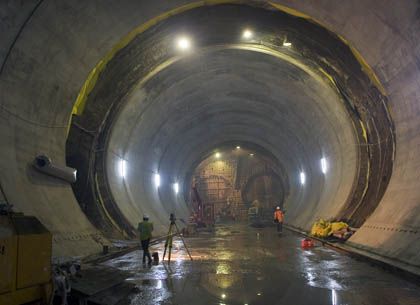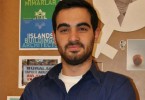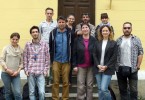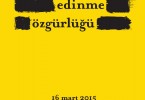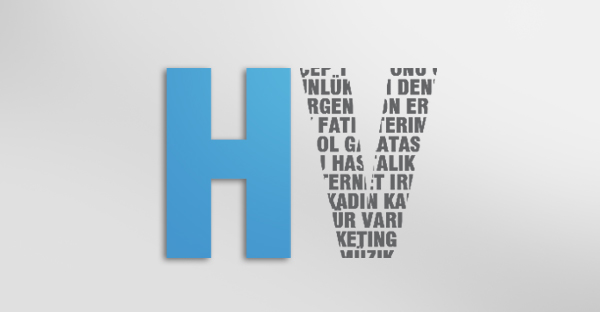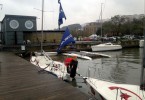Manon Loisel
“The Marmaray is going to change the face of Istanbul entirely,” says Nora Seni, director of the IFEA, French Institute of Anatolian Research. “Dazzling”, “providing freer movement”, “being better connected” and “revitalizing” are her keywords about the Marmaray tunnel project. The IFEA is involved in social studies and historical research. The Urban Observatory of Istanbul (OUI), a study group affiliated with IFEA, is focusing on urbanization, historical heritage and circulation of inhabitants in Istanbul. Nora Seni is conducting research in history and in urban problems. She used to teach at the Université Paris VIII before she took up her post at IFEA.
On the water’s surface the small passenger ferries called vapurs are shuttling back and forth between the Asian and European parts of Istanbul. But, under the water, a colossal project is near completion. The 2.5-billion Euro project is partly financed by Japanese and German investment banks. The Ottoman dream of linking the two parts of Istanbul underwater, first put forward by Sultan Abdul Mecit 150 years ago, is being realized. The first step for the realization of this idea was taken in 1987 with the drafting of a comprehensive feasibility report. The Marmaray Rail Tube Tunnel is going to connect Halkali, on the European side with Gebze in Asia by 76 kilometers of two-track commuter rail, with 1.4 kilometers running deep into the Bosporus.
Construction work started in October 2004 and laying down parts of the steel tube on the sea bed from Asia to Europe began in 2008.
But digging the ground in a city known to be inhabited by human beings since
Pre-historical times inevitably revealed lot of archaeological finds both on the European and Asian parts of the city. That caused work on Marmararay to fall behind schedule. Istanbul archaeologists have uncovered a 4th-Century port at the site where engineers were planning to build the ’/21st-Century railway hub. Work could not be started until the archeologists finish their excavation; a dream discovery for archeologists, but a nightmare for the Marmaray management. However, the completion of the Istanbul Strait crossing tunnels and stations were completed in 2009 and the integrated tests and trial operation are now going on. The commercial operation will start soon.
Everybody agrees that this project is a huge technological feat. “The most challenging infrastructure project in Turkey,” states the official website. Actually, this ambitious project also had to deal with dangerous conditions: Istanbul is located some 20 kilometers from the North Anatolian Fault Zone, which runs from east to west, south of the Prince’s Islands in the Marmara Sea. The risk of a severe earthquake must be taken into account. But the tunnels have been accordingly designed to resist an earthquake of maximum intensity that may be expected in the area.
But far from these technological aspects, this tunnel is going to change the face of Istanbul completely as Miss Seni points out. How does she, as a city planner and also as a historian, predict the new face of Istanbul, once this tunnel is completed?
“First, this tunnel should be a really good way to solve the traffic problem. To say that Istanbul has traffic problems is pure euphemism,” she says.
Some parts of the city are practically not accessible during rush hours. Going from Halkalı to Gebze today will typically last a bit more than three hours, including the ferry trip from Sirkeci to Haydarpaşa. When the upgraded commuter rail system starts operating, the trip will take one hour and forty-five minutes.
In the opening year commuters will save some 13 million hours.
“In the opening year, it has been calculated that the total time saved by commuters in terms of man hours will be in the order of 13 million hours, by the year 2015 the this figure will go up to 25 million hours, and by the year 2025, the savings will be in the order of approximately 100.000 hours (11.4 years) saved by people every single day all year round!” says the official website.
It will be the third route of commuting between Asia and Europe. The Turkish authorities were thinking of building a third bridge over the Bosporus, but this project encountered lots of opposition. “The tunnel project was the only solution, because a third bridge is too much. Also the location of the tunnel is very good; it is inside the city, in the center, where the traffic is dense and it is close to the Atatürk International Airport,” says Seni.
According to Seni, the choice of locations for stations that will function as hub points in Istanbul’s public transportation system is crucial. While making such decisions questions like convenience for passengers and the rapidity of transfers should be taken into account along with the respect for preserving the environment and historical monuments. “In some places like Sirkeci, even if the station is totally underground, I am concerned about the impact on historical buildings and the need for land requisition. I think that this issue has not been thought, conceptualized and adjusted enough before the construction of the tunnel.”
“This effort to ease circulation in Istanbul is part of the plans to change Istanbul’s global image.” The Marmaray tunnel accompanies Istanbul’s plans to become a world center for cultural, political and financial activities. A complex for international conferences is being built close to the Hilton Hotel and in recent years many landmark buildings of the city like the old slaughterhouse and the Ottoman fez factory on the banks of the Golden Horn have been turned into modern centers for international conferences and cultural activities.
But the city cannot function as such a global center as long as people cannot move from one place to the other. At rush hours, the tunnel will be able to carry around 75,000 people per hour in each way. This should significantly reduce boat traffic on the Bosporus and car congestion on land. Istanbul will then be able to be more attractive for international events. As Miss Seni puts it, the Marmaray is a way for Istanbul to dazzle the world. This “project of the century” is a way for Istanbul to impress the European Union, and the world.
According to Nora Seni, the Marmaray is also going to create a revitalization of the Asian part. “That does not mean that the Asian side is not a dynamic area at the moment, it is already central. For instance, the street of Baghdad is a multifunctional area, but this tunnel is going to affect the Asian side in different ways,” she says.
Firstly, it is going to promote housing in Asia. Considering the organization of the city, we can see that the housing areas of the European side are overloaded. This has led to a notable rise of prices, particularly in Beyoglu. But with the Marmaray, it will be much easier to live on the Asian side and to cross the Bosporus everyday to go to work. At the moment, people have to spend hours in traffic jams on the two bridges crossing the Bosporus. But, according to project managers, with this tunnel it will be possible to cross from one continent to the other in 17 minutes.
Secondly, the Marmaray is going to create and promote new centers. Nora Seni explains that in the Asian side, some new settlements are standing in the middle of “a kind of desert”. They lack infrastructure and a good traffic network which connects with the rest of the city. But thanks to the Marmaray, these settlements are going to be more attractive. But this does not mean that this tunnel should encourage the already sprawling city to continue its expansion. “The spreading means land plundering. That is why the idea of a third bridge has been opposed so vehemently. Further enlargement of city’s urban boundaries should be prevented at all costs,” she says.”

